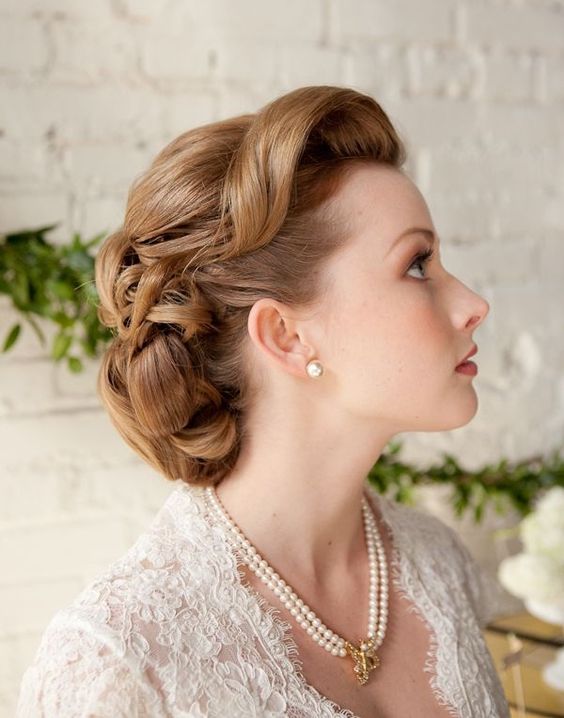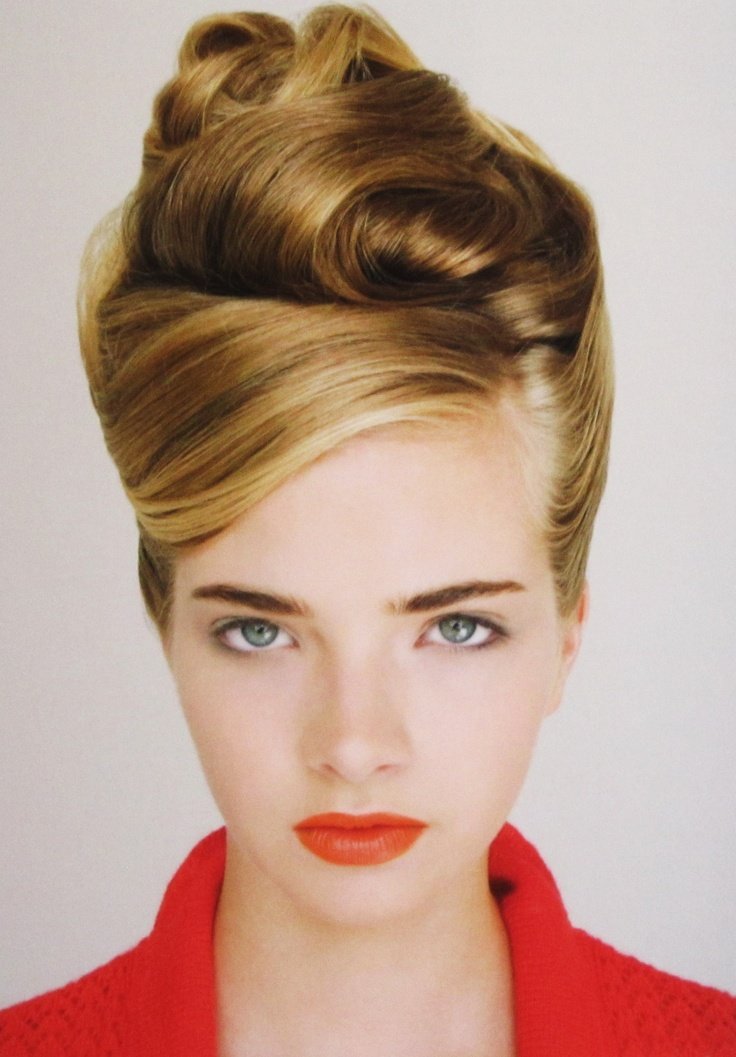1950 Vintage Updo Hairstyles: An Exploration of Post-War Elegance

The 1950s represented a pivotal era in fashion and beauty, emerging from the austerity of wartime into a period of renewed optimism, economic prosperity, and a pronounced return to overt femininity. Within this cultural landscape, sophisticated coiffures played a central role, with particular emphasis placed on meticulously styled updos. These elaborate arrangements were not merely practical ways to manage hair; they were statements of grace, refinement, and a commitment to a polished appearance, reflecting the decade’s broader aesthetic of structured elegance and aspirational glamour.
The distinctive characteristics of hairstyles from this period were rooted in precision, volume, and control. Unlike the more casual styles of earlier decades or the free-flowing looks that would emerge later, mid-century updos demanded careful construction. Hair was typically set in rollers or pin curls to create a foundation of waves and body, then meticulously brushed, backcombed, and sculpted into place. The objective was a smooth, neat finish, often with a prominent silhouette that added height and visual interest. Hair products, particularly setting lotions and the newly popularized hairspray, were indispensable tools in achieving and maintaining these elaborate constructions, ensuring every strand remained perfectly aligned.
Several iconic updo styles defined the look of What Is 3C Hair the era, each contributing to the decade’s diverse yet cohesive beauty standards.
One of the most recognizable forms of hair arrangement from the period is the Victory Roll. While its origins trace back to the early 1940s as a symbol of wartime resilience, it evolved and remained a prominent feature throughout the 1950s, often integrated into more elaborate updos. These distinctive rolls of hair, typically positioned at the front or sides of the head, created a voluminous, sculptural effect. They were achieved by backcombing sections of hair, then rolling them inwards or outwards to form a hollow tube or cylinder, which was then pinned securely. Often, two symmetrical rolls framed the face, lending an air of dramatic elegance. When incorporated into an updo, the remaining hair would be swept up into a chignon, a French twist, or an arrangement of pin curls at the nape of the neck, balancing the bold front with a refined back.
Another quintessential style was the French Twist. This timeless updo exuded unparalleled sophistication and was a staple for both daytime elegance and evening glamour. The technique involved gathering all the hair, twisting it upwards and inwards against the back of the head, and securing it vertically with pins. The finished look was a sleek, elongated roll of hair, often with a slight pouf or soft wave at the crown to add height and softness. The beauty of the French twist lay in its apparent simplicity, belying the careful technique required to achieve its smooth, seamless finish. It projected an image of effortless chic, making it a favorite among Hollywood stars and fashion-conscious women alike.
Chignons, or low buns, also held a significant place in the repertoire of elegant coiffures. Unlike the casual bun, the mid-century chignon was a carefully crafted arrangement, often positioned at the nape of the neck or slightly to one side. Hair was typically smoothed back, gathered into a ponytail, and then twisted, looped, or rolled into a neat, compact bun. Sometimes, it would be adorned with hairnets, ribbons, or decorative pins, elevating its formality. Chignons offered a refined and understated elegance, providing a perfect counterpoint to the era’s structured fashion silhouettes, particularly the “New Look” introduced by Christian Dior. They were versatile, suitable for professional settings, social gatherings, and formal events, always conveying a sense of meticulous grooming.
While the full-blown beehive gained its immense popularity in the early 1960s, the bouffant style, characterized by significant volume at the crown, was a clear precursor and a prominent feature in 1950s updos. Hair was heavily backcombed at the roots to create a substantial lift, then smoothed over to maintain a polished exterior. This voluminous crown was often paired with a French twist, a chignon, or even an elevated ponytail, adding drama and height to the overall silhouette. The bouffant communicated confidence and a sense of refined grandeur, embodying the era’s desire for larger-than-life glamour.
The influence of popular culture, particularly Hollywood cinema, cannot be overstated in shaping these trends. Actresses such as Grace Kelly, Audrey Hepburn, Elizabeth Taylor, and Marilyn Monroe, each with their distinct personas, popularized variations of these sophisticated coiffures. Their on-screen and red-carpet appearances set aspirational beauty standards, inspiring women globally to emulate their impeccably styled looks. The meticulously groomed appearance of these stars reinforced the idea that a woman’s hair was an essential component of her overall presentation, demanding attention and artistry.
Beyond aesthetics, the enduring appeal of these elaborate coiffures lies in their ability to convey a timeless sense of poise and meticulous self-presentation. They symbolized a period where beauty rituals were considered an integral part of daily life, reflecting a dedication to personal grooming and an appreciation for classic elegance. The structured nature of these looks also provided a sense of order and control, resonating with the post-war desire for stability and a return to traditional values.
The techniques employed to create these elaborate styles laid the groundwork for future hair trends, demonstrating the foundational importance of hair setting, backcombing, and precise pinning. The commitment to achieving a flawless finish, free from stray hairs, underscored a broader cultural value placed on perfection and attention to detail. Today, these styles are revered as hallmarks of a golden age of glamour, frequently revisited in fashion editorials, vintage-inspired events, and by individuals seeking to capture the distinctive charm of the mid-20th century. Their intricate beauty and historical significance ensure their continued relevance as a testament to an era of unparalleled sartorial and stylistic sophistication.
FAQs Regarding 1950 Vintage Updo Hairstyles
- What defined the overall aesthetic of updos from the 1950s?
The aesthetic was characterized by structured elegance, meticulous grooming, and a polished finish. Styles often featured significant volume, particularly at the crown or sides, achieved through backcombing and careful setting, with a strong emphasis on neatness and control over every strand. - Which specific techniques were essential for creating these elaborate looks?
Key techniques included wet setting hair with rollers or pin curls to build a foundation of waves and volume, extensive backcombing (teasing) for height, and precise pinning with bobby pins and hairnets to secure the intricate shapes. The application of setting lotions and hairspray was crucial for hold and smoothness. - Were these hairstyles practical for everyday wear, or primarily for special occasions?
Many of these coiffures, particularly simpler chignons or neat French twists, were adapted for daily wear by women who prioritized a groomed appearance. However, the more elaborate versions, featuring multiple victory rolls or complex arrangements, were often reserved for social events, evenings out, or formal occasions due to the time and effort required for their creation. - How did cultural influences impact the New Hair Style Cut For Men An Evolving Landscape Of Masculine Aesthetics popularity and design of these hair arrangements? The post-war era’s return to femininity, the economic boom, and the aspirational glamour portrayed by Hollywood actresses significantly influenced these hair trends. The “New Look” in fashion, with its emphasis on cinched waists and full skirts, also complemented the structured and voluminous nature of these coiffures, creating a cohesive aesthetic.
Tips for Recreating 1950 Vintage Updo Hairstyles
- Start with a Strong Foundation: Hair should be clean but not freshly washed, as second-day hair often holds style better. Apply a setting lotion or mousse to damp hair before blow-drying or setting in rollers to create lasting waves and volume.
- Master the Art of Setting: For authentic results, utilize hot rollers or traditional pin curls. Section hair carefully and roll it in the desired direction to establish the necessary curl pattern and volume before styling into an updo. Allow hair to cool completely before unrolling.
- Embrace Backcombing: To achieve the characteristic height and volume, especially for bouffants or victory rolls, backcomb sections of hair at the roots. Use a fine-tooth comb and work in small sections, gently smoothing the top layer for a polished finish.
- Utilize Proper Tools and Products: A strong-hold hairspray is indispensable for securing the style and taming flyaways. Bobby pins, U-pins, and a fine-mesh hairnet (especially for chignons or rolls) are essential for invisible and secure placement.
- Practice Patience and Precision: These coiffures demand attention to detail. Recreating them effectively requires patience and a methodical approach. Practice individual elements like rolling sections of hair or forming a neat twist before attempting the full updo.
Conclusion Regarding 1950 Vintage Updo Hairstyles
The intricate and elegant hair arrangements of the 1950s represent more than mere fashion trends; they embody a significant cultural moment characterized by a return to refined femininity and meticulous grooming. These sophisticated coiffures, from the architectural grandeur of Victory Rolls to the understated grace of the French Twist, were integral to the decade’s aesthetic, reflecting a broader societal value placed on presentation and poise. The dedication required to craft these elaborate looks underscored a commitment to personal elegance, transforming hair into an art form. Their enduring appeal lies in their timeless beauty and the statement of polished sophistication they convey. As such, these iconic styles remain a rich source of inspiration, offering a tangible connection to an era celebrated for its distinctive glamour and unwavering attention to detail in every aspect of personal style.







More suggestion: Modern Short Hairstyles For Over A Comprehensive Guide To Contemporary Chic